Science Daily News | 23 May 2023

Views (185)
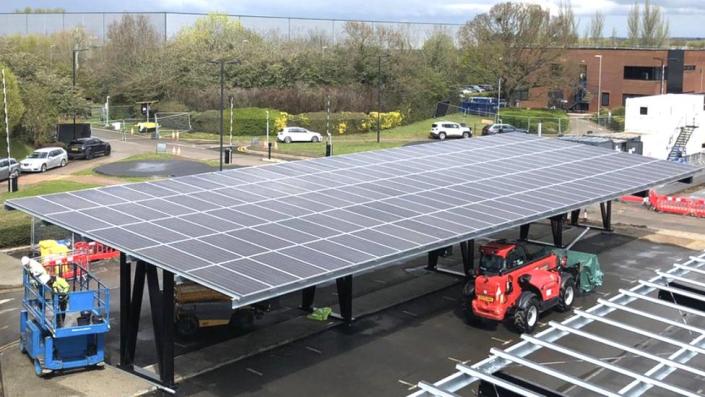
MARSBalloon: Gloucestershire school experiments to fly in space
The science project aims to mimic conditions similar to the atmosphere on Mars.
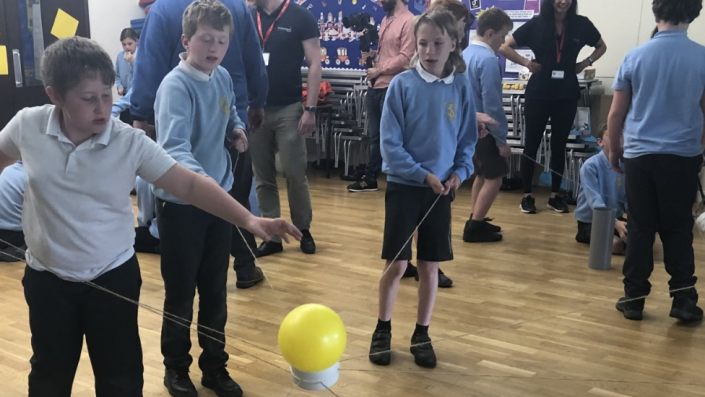
Science experiments created by primary school children are to be flown in space as part of a special project.
Pupils at Leonard Stanley Primary School, Gloucestershire, are taking part in workshops with global space manufacturer, Thales Alenia Space.
The experiments will be attached to a special balloon and sent 18 miles (30km) in the air where they will experience conditions similar to Mars.
The project is testing ideas that could one day be used on the red planet.
The MARSBalloon project, run by Thales Alenia Space, is a free scheme open to all schools and aims to test anything that humans or robots will be doing on Mars in the future.
During the four hour flight next month, the balloon will carry over 150 student experiments to an altitude of 30km, where they will be above 99% of Earth's atmosphere.
The tests will experience conditions similar to the surface of Mars, including temperatures of -50°C (-58°F), pressures 1/100th of that at sea level and an increased radiation dose.
When the balloon bursts, the experiments will then be recovered so students can analyse the results.
Year 6 pupils will be able to test the response of electronics, materials, plants and even food to the conditions outside of a future Mars base.
Propulsions Engineer at Thales Alenia Space, Drashti Shah, said the children had shown great awareness of the challenges of space: "I'm really impressed by the children's ability to understand the lack of gravity in space, you know, the impact it might have on daily life like water.
"Also the lack of oxygen and how you might need plants and trees to provide that lack of oxygen.
"They're not just thinking about the problem but they are thinking of a solution."
Headteacher at Leonard Stanley Primary School, Andrew Green, said he was keen for his school to take part in the initiative.
"To have that opportunity for them, to actually work with professionals...engaging in a project where the future potential of missions to Mars, communities on Mars...
"They feel like they are playing some small part in that."
The MARSBalloon initiative is also aiming to encourage more interest in science, technology and engineering.
Pupil Joss said she was inspired by the workshop: "Anyone can work in the Space Station if they're really smart and stuff, and I think more women should go up to space because it's an amazing experience."
The experiments from Leonard Stanley School will be flown into space in June.
Elephants enjoy zoo visitors, study suggests
Researchers find some animals react better than others to the presence of visitors.
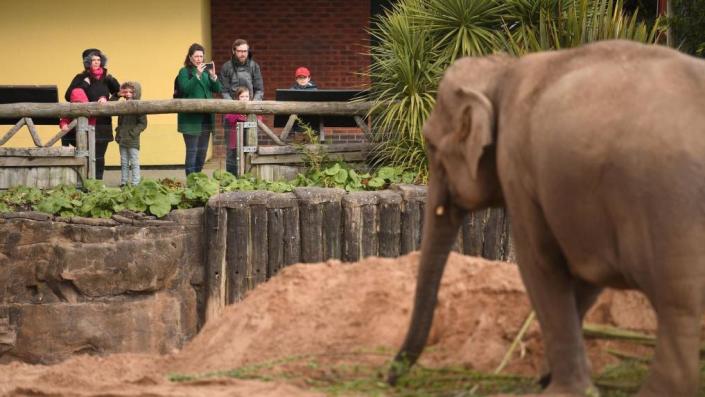
Elephants at zoos enjoy interacting with visitors, according to a new study.
Research by Harper Adams and Nottingham Trent universities found that the animals' positive behaviours such as social activity increased around visitors, while indicators of boredom decreased.
The study found other animals, including grizzly bears, polar bears and penguins also benefitted.
However some zoo animals, such as marsupials, ostriches and other flightless birds were found to react negatively to visitors.
The study, published in the journal Animals, explored the impact of visitors at zoos on more than 250 animal species.
With elephants, researchers found that after public feedings the animals would forage more and become more active.
At the same time, repetitive behaviours, which suggest boredom, decreased when large groups of visitors were around.
Other species which displayed positive responses included grizzly bears, polar bears, cheetahs, servals, bantengs, black-tailed prairie dogs and cockatoos.
"Zoo visitors are often aspects of a zoo animal's environment that animals cannot control and as such can be stressful, although some species appear to show good adaptability for the changing conditions of visitors," said Dr Samantha Ward, from Nottingham Trent University.
"There can be a lot of variation in stimuli from visitors in terms of their behaviour, the noise they make and the way they interact with the animals.,
"We have identified that species show varied responses to people in zoos - some cope well, others not so well."
Among the animals found not to cope so well were flightless birds, odd and even-toed ungulates, marsupials, tuatara and hedgehogs.
However the study found the reaction to visitors across all zoo animals was "predominantly neutral".
"Animal responses are attributed to various factors and recognising what these may be is important to improve welfare," said Dr Ellen Williams, a zoo animal welfare scientist at Harper Adams University in Shropshire.
"In elephants and birds it was encouraging to see a reduction in those repetitive behaviours towards something more positive in the presence of people, although the absence of change in the majority of species was also really good, because it suggests enclosure design is changing to better support animals in responding to visitors."
Kinsey Institute experts study sex, gender as misconceptions block state dollars
Unfounded claims about Indiana University’s sex research institute, its founder and child sex abuse have been so persistent over the years that when the Legislature prohibited the institute from using state dollars, one lawmaker hailed the move as “long overdue.” The decision, largely symbolic, does not halt the Kinsey Institute’s work, ranging from studies on sexual assault prevention to contraception use among women. Funding from the university remains unclear, but Zoe Peterson, senior scientist and director of the Sexual Assault Research Initiative at the Kinsey Institute, will continue her inquiries into consent and those who perpetrate sexual assault.
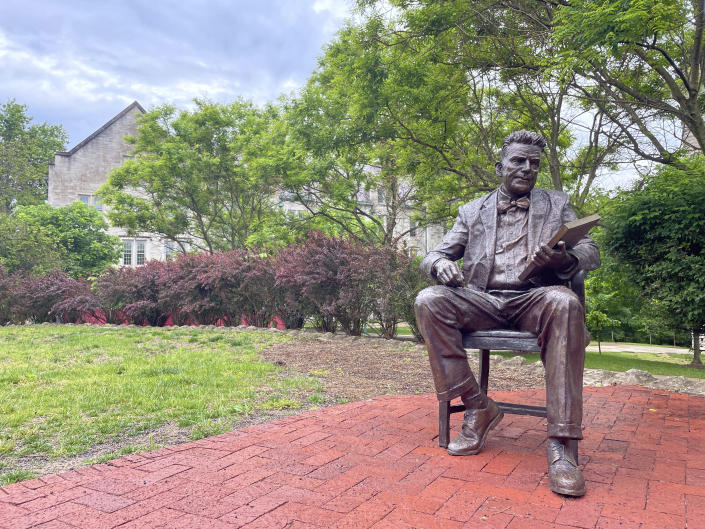
The decision, largely symbolic, does not halt the Kinsey Institute’s work, ranging from studies on sexual assault prevention to contraception use among women. But researchers tell The Associated Press the Republican-dominated Legislature’s February decision is based on an enduring, fundamental misunderstanding of their work — a false narrative that they, despite efforts to correct such misinformation, cannot shake.
Funding from the university remains unclear, but Zoe Peterson, senior scientist and director of the Sexual Assault Research Initiative at the Kinsey Institute, will continue her inquiries into consent and those who perpetrate sexual assault.
Contrary to what conspiracy theorists claim about the institute, “I’ve devoted my career to reducing sexual violence,” she said.
The Kinsey Institute, about 50 miles (82 kilometers) from Indianapolis on Indiana University's Bloomington campus, is named for Alfred Kinsey, a former professor who established the institute in 1947. He died in 1956.
Kinsey's major works, published in 1948 and 1953, disrupted cultural norms around sex, achieving commercial success and drawing praise, as well as sharp criticism from conservatives who continue to deride the institute.
In part, critics blame such research for wrongly contributing to a greater acceptance of homosexuality and pornography. But they also say there is evidence of child abuse in Kinsey's work, specifically a research table they unfoundedly claim resulted from sexual experiments on children.
“We have child rapists in Indiana prisons right now, yet we’re willing to give Indiana University, Bloomington campus, over $400 million as they protect the legacy of this sexual predator,” said Republican state Rep. Lorissa Sweet, who on Feb. 22 proposed the amendment to prohibit the institute from state funding.
“Who knows what they’re still hiding?” Sweet added.
Such accusations have lingered nearly since the Kinsey Institute’s inception 76 years ago, said Director Justin Garcia. Threats and harassment directed at staff and alumni over the allegations have become frequent, forcing the university to boost security that is already greater than most campus buildings, Garcia said.
“We've long been called ... perverts and sexual predators,” he said. “It’s just so far from reality, and it’s so far from the research practices then, and it’s wildly far from the research practices today.”
The move to block the institute's state dollars was based on “old, unproven” conspiracies, said Democratic Rep. Matt Pierce of Bloomington.
"These are warmed-over internet memes that keep coming back,” he said before the House vote.
Professor Carolyn Halpern teaches her students about Kinsey in the Department of Maternal and Child Health at the University of North Carolina, Chapel Hill, she said. When she heard about Indiana curtailing Kinsey Institute funding, she thought, “Here we go again.”
“Sexuality research tends to get targeted, often for political reasons,” Halpern said. “It’s another attack on legitimate research.”
“It reinforces, for me, the importance of the research being done here," she said.
And that research, along with the work of other public colleges and universities, could be at risk as the Legislature uses funding to “dictate” what questions can be asked within a specific program, the institute's director said.
“It’s a chilling precedent," Garcia said, a sentiment shared by Indiana University President Pamela Whitten.
The university is “firmly committed to academic freedom," Whitten said in an April 28 statement. A "thorough legal review” is underway to determine if the university can comply with the law while ensuring research continues, she said.
Garcia said about two-thirds of the institute's funding comes from grants and donations that are subject to change annually. The university would typically fund the rest.
As officials work to understand the law, researchers pursue their projects, gathering in a space where erotic art often adorns the walls of most rooms. The building boasts explicit sketches and sculptures, while vivid photographs of mothers in labor lead into an exhibit featuring a 1984 turquoise poster: “Great Sex! Don't let AIDS stop it,” it reads.
Life-sized Kinsey himself — clad in bowtie, cuffed pants and suit jacket — reposes in a chair just beyond the institute's entrance. Frozen in bronze, he gazes at an empty, transparent resin chair across from him, an inquisitive expression on his carved face, an indecipherable research table in his left hand.
“There’s a lot of openness and transparency," Graham said. “But there’s some people that aren’t going to look at that.”
___
This is your daily reminder that orcas are just giant dolphins
Orcas, also known as killer whales, are not whales at all. They're actually part of the Delphinidae family and are the largest dolphin in the sea.
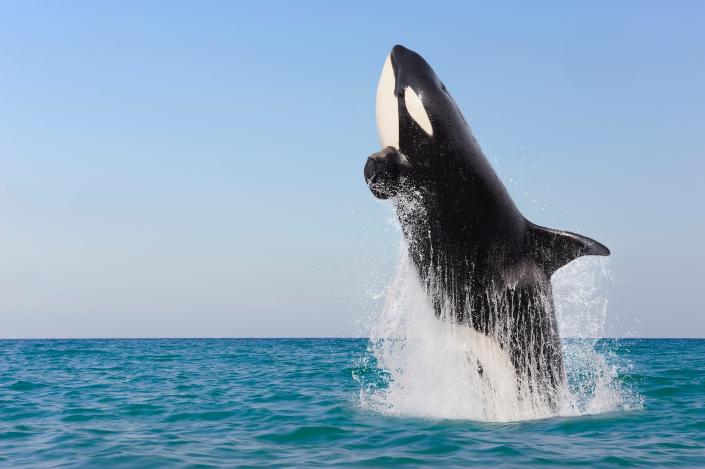
The name "killer whale" is a misnomer. Orcas, aka killer whales, are actually dolphins.
Orcas are the largest member of the Delphinidae family, which includes dolphins and other species.
Like dolphins, orcas are highly intelligent and social animals as well as the sea's apex predators.
But on a more granular level, whales and dolphins are taxonomically distinct. Put another way, all dolphins are whales but not all whales are dolphins.
New £12.5m research hub to open in Inverness
The Rural and Veterinary Innovation Centre is being set up to help tackle challenges faced by agriculture.

A new research facility is to open in Inverness with the aim of helping tackle challenges animal diseases and climate change pose to agriculture.
The £12.5m Rural and Veterinary Innovation Centre (RAVIC) is due to be fully up and running later this year.
The project is being led by Scotland's Rural College (SRUC).
RAVIC will house SRUC's existing Centre for Epidemiology and Planetary Health and form part of Scotland's new School of Veterinary Medicine.
The project has been funded by the European Regional Development Fund, the Scottish Funding Council and SRUC.
Businesses and entrepreneurs have been sought to take residence at the centre and help develop new products, services and solutions to overcome a range of problems, including food security.
RAVIC is also to work closely with SRUC's Veterinary Surveillance Intelligence Unit, recently developed to provide new ways to help farmers deal with animal diseases, increase livestock production efficiency and reduce carbon emissions.
Under construction at Highlands and Islands Enterprise's Inverness Campus, the centre will have several commercial business incubation units, a lecture theatre and laboratories.
Director Prof George Gunn said: "The Highland innovation centre will help short circuit the gap that exists between science and business to unlock the true potential of Scotland's blue and green economies to create high value jobs.
"The development reinforces SRUC's commitment to expanding its regional presence in the area and it will also be an important addition to the existing range of expertise already on Inverness Campus."
Why car parks are the hottest space in solar
Car parks are a good place for solar panels, providing shade and electricity where it is needed.
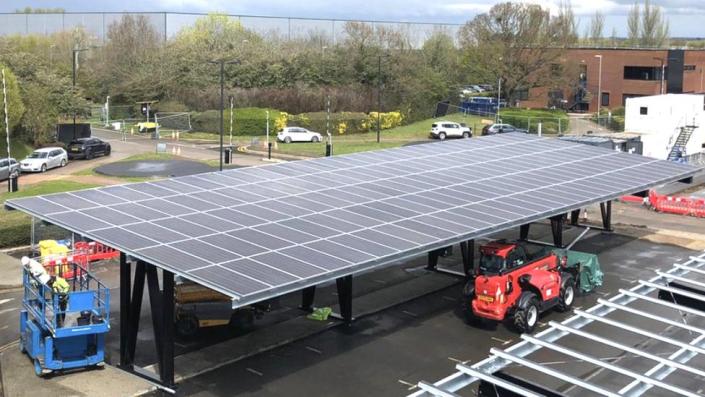
There's more than just cars and empty spaces in this car park. Huge arrays of angled solar panels sit atop jet black steel supports, soaking up the sun and shading the vehicles beneath.
Outside the offices of a major car manufacturer in the south of England, there are now more than 2,000 panels in total with a peak capacity of just under 1 megawatt (MW).
"They are looking stunning," declares Guy Chilvers, business development manager at SIG, the firm that installed the solar canopies.
These structures make car parks more visually appealing, he insists, while admitting, "I would say that".
Solar car parks or car ports enable electricity production in open spaces that tend to be positioned conveniently near to energy-guzzling facilities such as hospitals, shopping centres or offices. The canopies have additional benefits in that they protect cars from rain and snow, or hot sun in the summer.
There is a huge opportunity to turn more British car parks into solar farms, according to a new report published by the countryside charity CPRE and the UCL Energy Institute.
"We think the total potential in the built environment is about 117GW," says Prof Mark Barrett of UCL. "And of that, 11GW, we think, is car parks."
Whichever way you look at it, there's plenty of space out there in car parks for solar panels and people are beginning to realise this.
"It's absolutely gone crazy," says Mr Chilvers, referring to his inbox. Lately, he's quoted for hotels, hospitals and leisure centres. Mr Chilvers and his colleagues design and build the steel structures for solar canopies while the panels are supplied separately.
Rival companies that spoke to the BBC also described high demand for solar car park canopies.
Praxia Energy, based in Spain, supplies about 3MW of car park solar installations in the UK each year and says it expects this to grow tenfold by 2028.
A spokeswoman for Veolia says the company recently installed a 1.1MW solar canopy system in the car park of Eastbourne Hospital and the firm has registered increased demand for solar infrastructure in the UK lately.
Solarsense, a company in Clevedon, says it has also received rising enquiries in recent months.
Tim Evans, chief executive of 3ti, argues that, in the past, the UK has been slow to pursue this technology in comparison with countries on the continent. "We are quite some way behind the curve," he says.
There are some flagship examples already in place, though. The largest solar car park installed to date in the UK is the one at the Bentley car factory in Crewe, which has a peak capacity of 2.7MW.
Mr Evans says he is currently exploring four new potential projects with clients that could exceed 5MW peak capacity.
Solar panels in car parks can also power electric vehicle (EV) charging. This works especially well at offices, where employees' cars are parked outside for many hours. Shopping centres, football stadiums, leisure centres and cinemas are also suitable venues, since cars tend to be parked for two hours or more to allow sufficient charging, says Mr Evans.
But the steel supports required for many solar canopies do add to the cost. It is often cheaper to simply put solar panels on the roof of large buildings, such as supermarkets. Mr Evans estimates that rooftop solar yields electricity at about 9p per kWh currently, versus 14p or 15p per kWh from panels in car parks.
There aren't many other obvious downsides to the canopies, though, says Richard Watkins at the University of Kent. He notes that installers might want to fit them with efficient under-canopy lighting so that they don't result in dark, potentially dangerous spaces at night.
"I've just had a megawatt car park, beautiful car park, for a factory turned down because it can't get a grid connection," says Mr Chilvers.
A spokesman for Solar Energy UK also highlights this problem, saying that solar car parks becoming a common sight will remain a "distant prospect" until it is resolved.
There are lots of other locations around the UK, besides car parks, that could also accommodate solar installations and help us ditch fossil fuels, notes Prof Sara Walker at Newcastle University. Cycle paths and railways, for instance, or reservoirs that can be covered with floating solar panels. These also help reduce the evaporative loss of water from reservoirs.
"Where we can co-locate solar photovoltaics alongside infrastructure that would be there anyway, like a car park, it enables us to get double use out of the land surface," she says.
0 Likes
